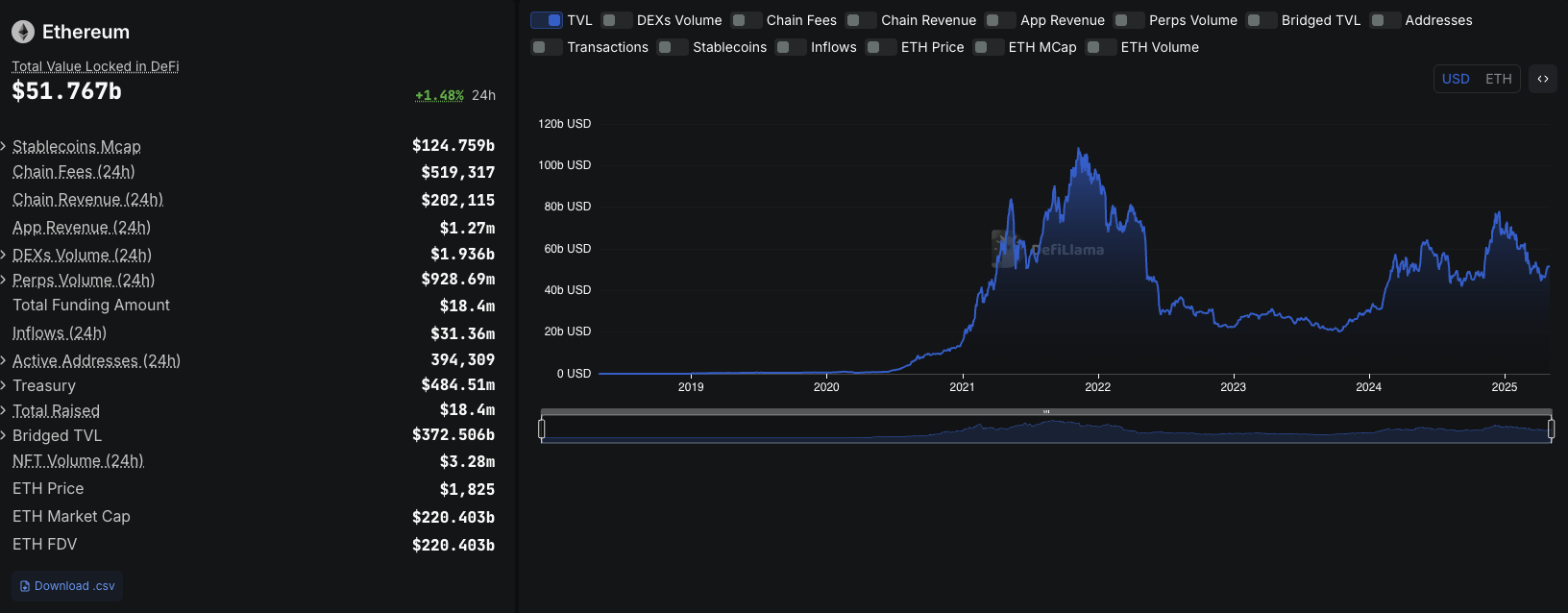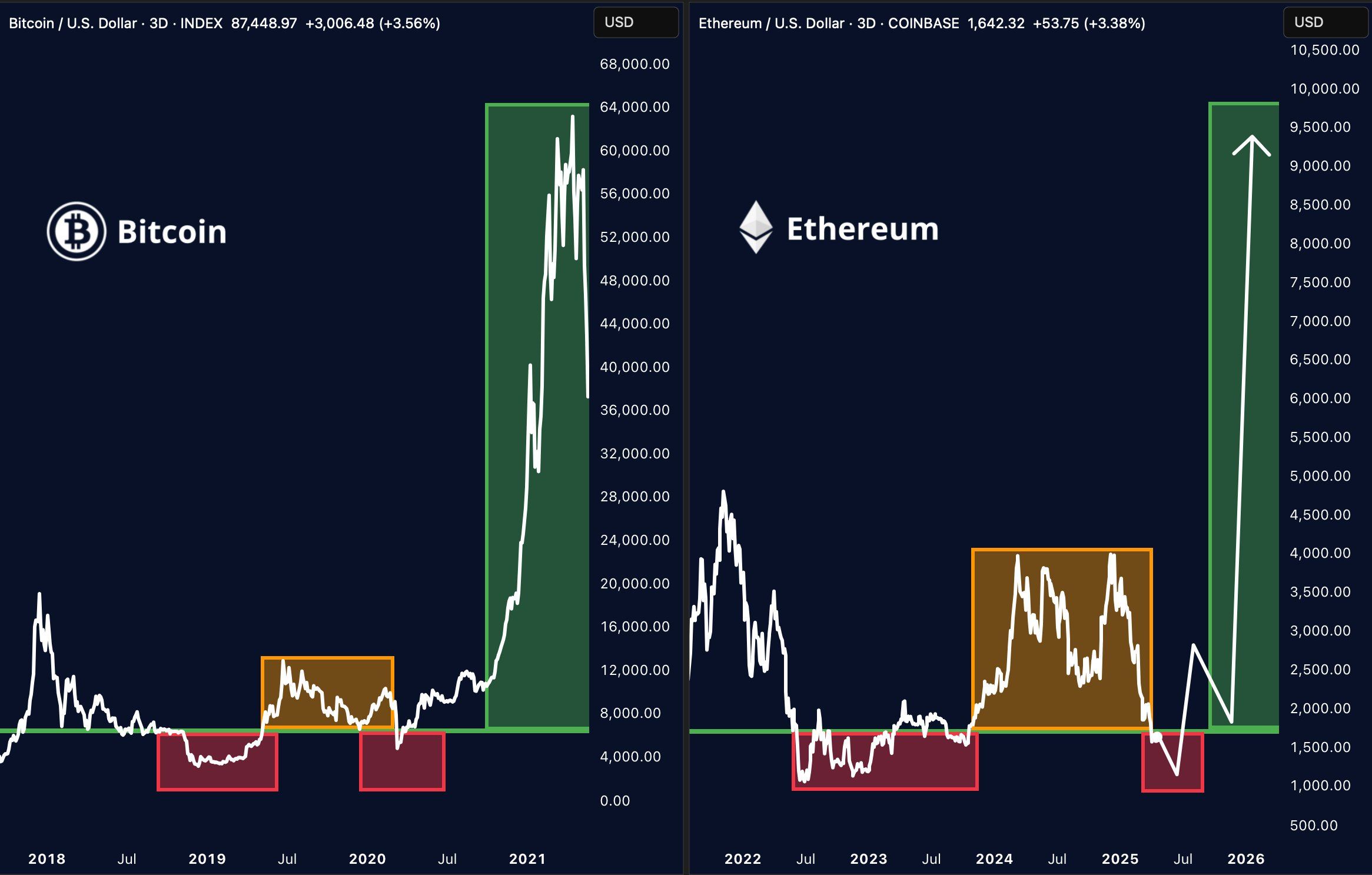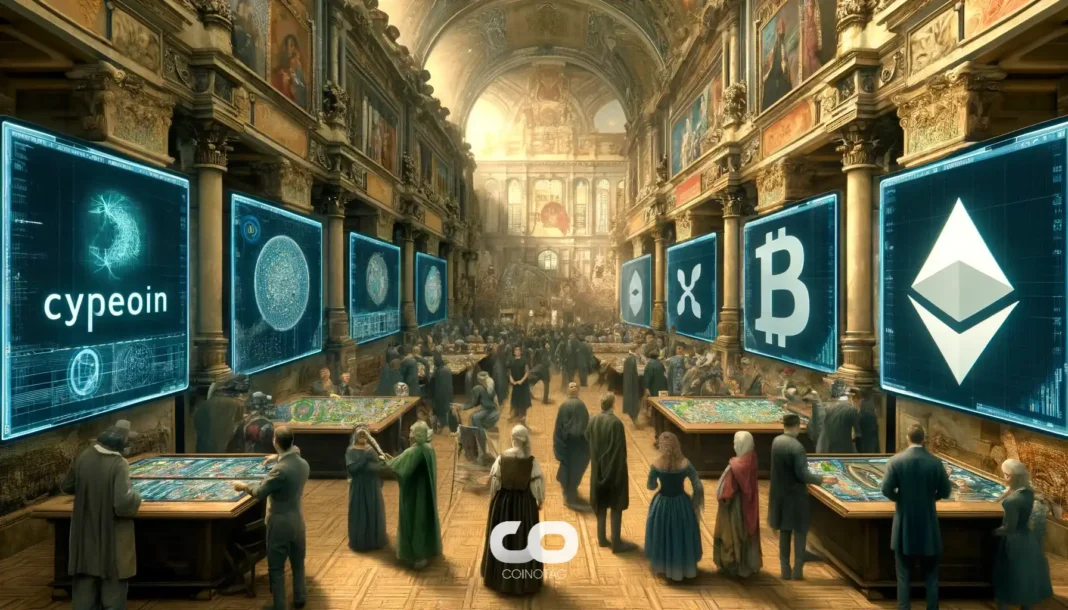| COINOTAG recommends • Exchange signup |
| 💹 Trade with pro tools |
| Fast execution, robust charts, clean risk controls. |
| 👉 Open account → |
| COINOTAG recommends • Exchange signup |
| 🚀 Smooth orders, clear control |
| Advanced order types and market depth in one view. |
| 👉 Create account → |
| COINOTAG recommends • Exchange signup |
| 📈 Clarity in volatile markets |
| Plan entries & exits, manage positions with discipline. |
| 👉 Sign up → |
| COINOTAG recommends • Exchange signup |
| ⚡ Speed, depth, reliability |
| Execute confidently when timing matters. |
| 👉 Open account → |
| COINOTAG recommends • Exchange signup |
| 🧭 A focused workflow for traders |
| Alerts, watchlists, and a repeatable process. |
| 👉 Get started → |
| COINOTAG recommends • Exchange signup |
| ✅ Data‑driven decisions |
| Focus on process—not noise. |
| 👉 Sign up → |
-
Ethereum whales display contrasting strategies amid market fluctuations, with some accumulating significant holdings while others opt to sell.
-
Despite a 5% decline in ETH price early May 2025, institutional inflows and robust DeFi metrics indicate strong underlying confidence.
-
Short positions by whales and increased exchange deposits introduce short-term risks, yet upgrades and layer implementation suggest an optimistic outlook.
Ethereum’s market showcases a split among whales, revealing both accumulating and selling pressures, which shape the cryptocurrency’s current landscape.
Contrasting Ethereum Whales’ Actions
Recent activities among Ethereum whales demonstrate a stark divergence in investment strategies. Some prominent investors are actively accumulating ETH, as illustrated by a notable purchase of 3,029.6 ETH, valued at $5.74 million, despite a temporary loss of $142,000 due to falling prices.
Data from Lookonchain highlighted that numerous whale addresses amassed thousands of ETH in just a couple of hours on May 1, 2025, signaling that certain major players retain confidence in Ethereum’s long-term trajectory, undeterred by short-term volatility.
Conversely, substantial selling pressure is evident from some whales. Reports indicate that on May 2, a whale deposited 2,680 ETH onto Kraken, facing potentially hefty losses around $255,000. Additionally, another whale transferred 3,000 ETH to Kraken in under 10 minutes, a decisive step towards selling.
| COINOTAG recommends • Professional traders group |
| 💎 Join a professional trading community |
| Work with senior traders, research‑backed setups, and risk‑first frameworks. |
| 👉 Join the group → |
| COINOTAG recommends • Professional traders group |
| 📊 Transparent performance, real process |
| Spot strategies with documented months of triple‑digit runs during strong trends; futures plans use defined R:R and sizing. |
| 👉 Get access → |
| COINOTAG recommends • Professional traders group |
| 🧭 Research → Plan → Execute |
| Daily levels, watchlists, and post‑trade reviews to build consistency. |
| 👉 Join now → |
| COINOTAG recommends • Professional traders group |
| 🛡️ Risk comes first |
| Sizing methods, invalidation rules, and R‑multiples baked into every plan. |
| 👉 Start today → |
| COINOTAG recommends • Professional traders group |
| 🧠 Learn the “why” behind each trade |
| Live breakdowns, playbooks, and framework‑first education. |
| 👉 Join the group → |
| COINOTAG recommends • Professional traders group |
| 🚀 Insider • APEX • INNER CIRCLE |
| Choose the depth you need—tools, coaching, and member rooms. |
| 👉 Explore tiers → |
Notably, a whale who garnered 76,000 ETH during the ICO chose to offload 6,000 ETH, potentially netting a profit of $10.92 million. Another whale increased their short position by borrowing an additional 4,000 ETH, now holding a total short position of 10,000 ETH, valued at approximately $18.4 million.
Market Context and Investor Sentiment
The current volatility among whales corresponds with broader market dynamics. A report from COINOTAG indicates that ETH gained 10% over the past week but faced a recent dip, currently sitting at approximately $1,842—a notable fall from the March peak of $2,500.
| COINOTAG recommends • Exchange signup |
| 📈 Clear interface, precise orders |
| Sharp entries & exits with actionable alerts. |
| 👉 Create free account → |
| COINOTAG recommends • Exchange signup |
| 🧠 Smarter tools. Better decisions. |
| Depth analytics and risk features in one view. |
| 👉 Sign up → |
| COINOTAG recommends • Exchange signup |
| 🎯 Take control of entries & exits |
| Set alerts, define stops, execute consistently. |
| 👉 Open account → |
| COINOTAG recommends • Exchange signup |
| 🛠️ From idea to execution |
| Turn setups into plans with practical order types. |
| 👉 Join now → |
| COINOTAG recommends • Exchange signup |
| 📋 Trade your plan |
| Watchlists and routing that support focus. |
| 👉 Get started → |
| COINOTAG recommends • Exchange signup |
| 📊 Precision without the noise |
| Data‑first workflows for active traders. |
| 👉 Sign up → |

Nonetheless, market sentiment shows positive signals. Recent inflows into Ethereum investment products reached $183 million, reversing an eight-week outflow trend. Notably, the Ethereum spot ETF reported a total net inflow of $6.4932 million, underscoring institutional interest amidst whale selling pressure.
| COINOTAG recommends • Traders club |
| ⚡ Futures with discipline |
| Defined R:R, pre‑set invalidation, execution checklists. |
| 👉 Join the club → |
| COINOTAG recommends • Traders club |
| 🎯 Spot strategies that compound |
| Momentum & accumulation frameworks managed with clear risk. |
| 👉 Get access → |
| COINOTAG recommends • Traders club |
| 🏛️ APEX tier for serious traders |
| Deep dives, analyst Q&A, and accountability sprints. |
| 👉 Explore APEX → |
| COINOTAG recommends • Traders club |
| 📈 Real‑time market structure |
| Key levels, liquidity zones, and actionable context. |
| 👉 Join now → |
| COINOTAG recommends • Traders club |
| 🔔 Smart alerts, not noise |
| Context‑rich notifications tied to plans and risk—never hype. |
| 👉 Get access → |
| COINOTAG recommends • Traders club |
| 🤝 Peer review & coaching |
| Hands‑on feedback that sharpens execution and risk control. |
| 👉 Join the club → |
Additionally, a significant short position of 10,000 ETH implies expectations for possible near-term price declines, which could exacerbate downward price movements if general market sentiment shifts negatively.
Retail investors seem impacted by this uncertainty, as evidenced by a 10% decrease in ETH trading volume on exchanges in the last 24 hours.
Risks and Opportunities
The contrast in whale behavior presents a crossroads for investors, balancing inherent risks against unique opportunities. The significant selling pressure from some whales, coupled with considerable short positions, poses a risk of price declines in the near term, especially in an overbought environment.

| COINOTAG recommends • Exchange signup |
| 📈 Clear control for futures |
| Sizing, stops, and scenario planning tools. |
| 👉 Open futures account → |
| COINOTAG recommends • Exchange signup |
| 🧩 Structure your futures trades |
| Define entries & exits with advanced orders. |
| 👉 Sign up → |
| COINOTAG recommends • Exchange signup |
| 🛡️ Control volatility |
| Automate alerts and manage positions with discipline. |
| 👉 Get started → |
| COINOTAG recommends • Exchange signup |
| ⚙️ Execution you can rely on |
| Fast routing and meaningful depth insights. |
| 👉 Create account → |
| COINOTAG recommends • Exchange signup |
| 📒 Plan. Execute. Review. |
| Frameworks for consistent decision‑making. |
| 👉 Join now → |
| COINOTAG recommends • Exchange signup |
| 🧩 Choose clarity over complexity |
| Actionable, pro‑grade tools—no fluff. |
| 👉 Open account → |
However, the accumulating trades by whales reflect long-term confidence in Ethereum, particularly as the network maintains its leadership in decentralized finance, boasting a total value locked (TVL) of $52 billion as of May 2025, according to DefiLlama.
Market analysts have likened Ethereum’s current price structure to that of Bitcoin in 2020, suggesting a potential for substantial growth should historical patterns repeat.
| COINOTAG recommends • Members‑only research |
| 📌 Curated setups, clearly explained |
| Entry, invalidation, targets, and R:R defined before execution. |
| 👉 Get access → |
| COINOTAG recommends • Members‑only research |
| 🧠 Data‑led decision making |
| Technical + flow + context synthesized into actionable plans. |
| 👉 Join now → |
| COINOTAG recommends • Members‑only research |
| 🧱 Consistency over hype |
| Repeatable rules, realistic expectations, and a calmer mindset. |
| 👉 Get access → |
| COINOTAG recommends • Members‑only research |
| 🕒 Patience is an edge |
| Wait for confirmation and manage risk with checklists. |
| 👉 Join now → |
| COINOTAG recommends • Members‑only research |
| 💼 Professional mentorship |
| Guidance from seasoned traders and structured feedback loops. |
| 👉 Get access → |
| COINOTAG recommends • Members‑only research |
| 🧮 Track • Review • Improve |
| Documented PnL tracking and post‑mortems to accelerate learning. |
| 👉 Join now → |

However, competition may intensify for Ethereum as platforms like Solana enhance developer support and improve user experiences. Yet, advancements such as Ethereum 2.0 and the expansion of Layer 2 solutions like Arbitrum and Optimism can bolster ETH’s long-term prospects.
| COINOTAG recommends • Exchange signup |
| 🎯 Focus on process over noise |
| Plan trades, size positions, execute consistently. |
| 👉 Sign up → |
| COINOTAG recommends • Exchange signup |
| 🛠️ Simplify execution |
| Keep decisions clear with practical controls. |
| 👉 Get started → |
| COINOTAG recommends • Exchange signup |
| 📊 Make data your edge |
| Use depth and alerts to avoid guesswork. |
| 👉 Open account → |
| COINOTAG recommends • Exchange signup |
| 🧭 Be prepared, not reactive |
| Turn setups into rules before you trade. |
| 👉 Create account → |
| COINOTAG recommends • Exchange signup |
| ✍️ Plan first, then act |
| Entries, exits, and reviews that fit your routine. |
| 👉 Join now → |
| COINOTAG recommends • Exchange signup |
| 🧩 Consistency beats intensity |
| Small, repeatable steps win the long run. |
| 👉 Sign up → |
While current price levels may attract accumulating strategies, investors should remain vigilant towards whale activities and market indicators to mitigate potential correction risks.
Conclusion
The actions of Ethereum whales encapsulate a complex narrative, intertwining both caution and optimism. As the market navigates these turbulent waters, investors must discern between short-term pressures and long-term opportunities, keeping a close watch on whale movements and market indicators to effectively navigate this landscape.
| COINOTAG recommends • Premium trading community |
| 🏛️ WAGMI CAPITAL — Premium Trading Community |
| Strategic insights, exclusive opportunities, professional support. |
| 👉 Join WAGMI CAPITAL → |
| COINOTAG recommends • Premium trading community |
| 💬 Inner Circle access |
| See members share real‑time PnL and execution notes in chat. |
| 👉 Apply for Inner Circle → |
| COINOTAG recommends • Premium trading community |
| 🧩 Turn theses into trades |
| Reusable templates for entries, risk, and review—end to end. |
| 👉 Join the club → |
| COINOTAG recommends • Premium trading community |
| 💡 Long‑term mindset |
| Patience and discipline over noise; a process that compounds. |
| 👉 Get started → |
| COINOTAG recommends • Premium trading community |
| 📚 Education + execution |
| Courses, playbooks, and live market walkthroughs—learn by doing. |
| 👉 Get access → |
| COINOTAG recommends • Premium trading community |
| 🔒 Members‑only research drops |
| Curated analyses and private briefings—quality over quantity. |
| 👉 Join WAGMI CAPITAL → |
| COINOTAG recommends • Members‑only research |
| 📌 Curated setups, clearly explained |
| Entry, invalidation, targets, and R:R defined before execution. |
| 👉 Get access → |
| COINOTAG recommends • Members‑only research |
| 🧠 Data‑led decision making |
| Technical + flow + context synthesized into actionable plans. |
| 👉 Join now → |
| COINOTAG recommends • Members‑only research |
| 🧱 Consistency over hype |
| Repeatable rules, realistic expectations, and a calmer mindset. |
| 👉 Get access → |
| COINOTAG recommends • Members‑only research |
| 🕒 Patience is an edge |
| Wait for confirmation and manage risk with checklists. |
| 👉 Join now → |
| COINOTAG recommends • Members‑only research |
| 💼 Professional mentorship |
| Guidance from seasoned traders and structured feedback loops. |
| 👉 Get access → |
| COINOTAG recommends • Members‑only research |
| 🧮 Track • Review • Improve |
| Documented PnL tracking and post‑mortems to accelerate learning. |
| 👉 Join now → |










